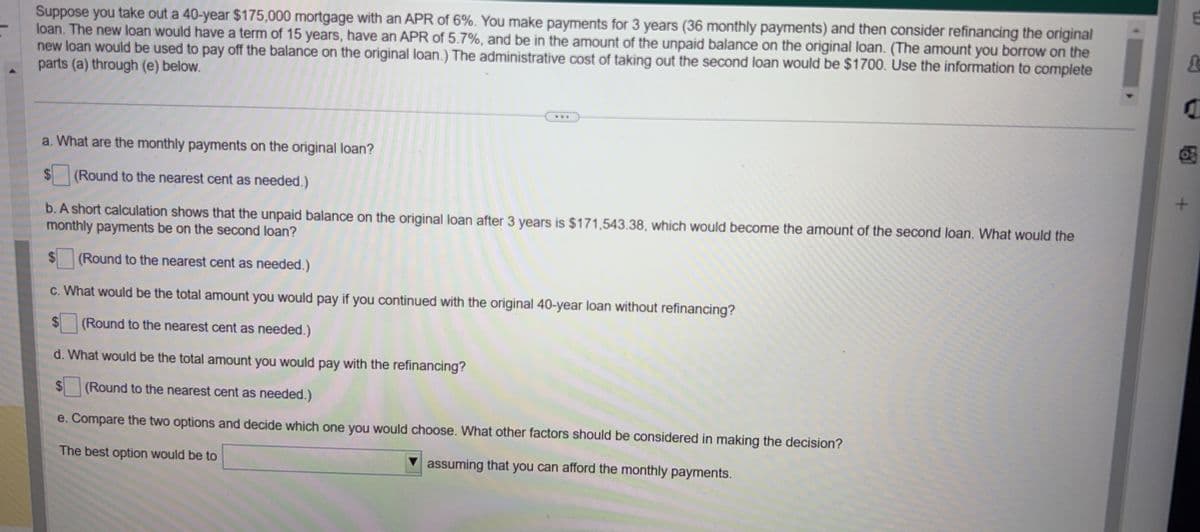a. What are the monthly payments on the original loan? $ (Round to the nearest cent as needed.) b. A short calculation shows that the unpaid balance on the original loan after 3 years is $171,543.38, which would become the amount of the second loan. What would the monthly payments be on the second loan? (Round to the nearest cent as needed.) c. What would be the total amount you would pay if you continued with the original 40-year loan without refinancing? (Round to the nearest cent as needed.) d. What would be the total amount you would pay with the refinancing? (Round to the nearest cent as needed.) e. Compare the two options and decide which one you would choose. What other factors should be considered in making the decision? The best option would be to assuming that you can afford the monthly payments.
a. What are the monthly payments on the original loan? $ (Round to the nearest cent as needed.) b. A short calculation shows that the unpaid balance on the original loan after 3 years is $171,543.38, which would become the amount of the second loan. What would the monthly payments be on the second loan? (Round to the nearest cent as needed.) c. What would be the total amount you would pay if you continued with the original 40-year loan without refinancing? (Round to the nearest cent as needed.) d. What would be the total amount you would pay with the refinancing? (Round to the nearest cent as needed.) e. Compare the two options and decide which one you would choose. What other factors should be considered in making the decision? The best option would be to assuming that you can afford the monthly payments.
Pfin (with Mindtap, 1 Term Printed Access Card) (mindtap Course List)
7th Edition
ISBN:9780357033609
Author:Randall Billingsley, Lawrence J. Gitman, Michael D. Joehnk
Publisher:Randall Billingsley, Lawrence J. Gitman, Michael D. Joehnk
Chapter7: Using Consumer Loans
Section: Chapter Questions
Problem 4FPE: Calculating single-payment loan amount due at maturity. Stanley Price plans to borrow 8,000 for five...
Related questions
Question
Suppose that you take out a 40-year $175000 mortgage with an APR of 6%. You make payments for 3 years and then you consider refinancing the original loan. The new loan would have a term of 15 years, have and APR of 5.7% and be in the amount of the unpaid balance on the original loan. The administrative cost of taking out the second loan would be $1700. What are the monthly payments on the original loan? What would the monthly payment of the second loan be? What would the total amount you would pay if you continued with the original 40-year loan without refinancing? What would the total amount would you pay with the refinancing?

Transcribed Image Text:Suppose you take out a 40-year $175,000 mortgage with an APR of 6%. You make payments for 3 years (36 monthly payments) and then consider refinancing the original
loan. The new loan would have a term of 15 years, have an APR of 5.7%, and be in the amount of the unpaid balance on the original loan. (The amount you borrow on the
new loan would be used to pay off the balance on the original loan.) The administrative cost of taking out the second loan would be $1700. Use the information to complete
parts (a) through (e) below.
a. What are the monthly payments on the original loan?
(Round to the nearest cent as needed.)
b. A short calculation shows that the unpaid balance on the original loan after 3 years is $171,543.38, which would become the amount of the second loan. What would the
monthly payments be on the second loan?
$(Round to the nearest cent as needed.)
c. What would be the total amount you would pay if you continued with the original 40-year loan without refinancing?
$
(Round to the nearest cent as needed.)
d. What would be the total amount you would pay with the refinancing?
$
(Round to the nearest cent as needed.)
e. Compare the two options and decide which one you would choose. What other factors should be considered in making the decision?
The best option would be to
assuming that you can afford the monthly payments.
$
1
4
+
Expert Solution
Trending now
This is a popular solution!
Step by step
Solved in 9 steps

Knowledge Booster
Learn more about
Need a deep-dive on the concept behind this application? Look no further. Learn more about this topic, finance and related others by exploring similar questions and additional content below.Recommended textbooks for you

Pfin (with Mindtap, 1 Term Printed Access Card) (…
Finance
ISBN:
9780357033609
Author:
Randall Billingsley, Lawrence J. Gitman, Michael D. Joehnk
Publisher:
Cengage Learning

EBK CONTEMPORARY FINANCIAL MANAGEMENT
Finance
ISBN:
9781337514835
Author:
MOYER
Publisher:
CENGAGE LEARNING - CONSIGNMENT

Principles of Accounting Volume 2
Accounting
ISBN:
9781947172609
Author:
OpenStax
Publisher:
OpenStax College

Pfin (with Mindtap, 1 Term Printed Access Card) (…
Finance
ISBN:
9780357033609
Author:
Randall Billingsley, Lawrence J. Gitman, Michael D. Joehnk
Publisher:
Cengage Learning

EBK CONTEMPORARY FINANCIAL MANAGEMENT
Finance
ISBN:
9781337514835
Author:
MOYER
Publisher:
CENGAGE LEARNING - CONSIGNMENT

Principles of Accounting Volume 2
Accounting
ISBN:
9781947172609
Author:
OpenStax
Publisher:
OpenStax College

Intermediate Financial Management (MindTap Course…
Finance
ISBN:
9781337395083
Author:
Eugene F. Brigham, Phillip R. Daves
Publisher:
Cengage Learning

